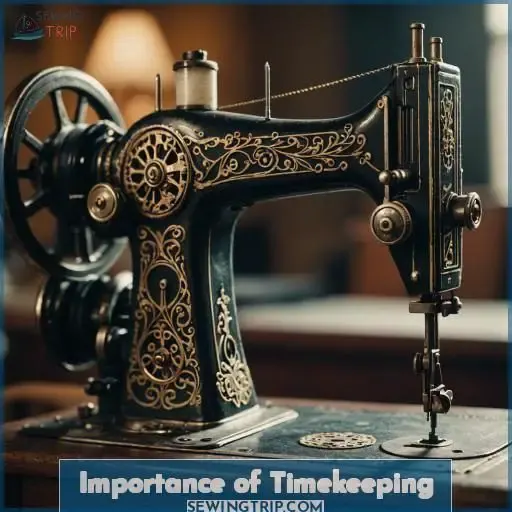This site is supported by our readers. We may earn a commission, at no cost to you, if you purchase through links.
 Determining how long sewing projects take depends on several factors.
Determining how long sewing projects take depends on several factors.
The fabric’s weight, drape, texture, color, and finish impact construction time.
Techniques like serging seams efficiently, but added details like flat-felled seams, pockets, zippers, and unassembled waistbands increase duration.
Embellishments enhance charm but intensify intricacy.
Tailoring augments quality but necessitates more stages.
Utilizing time-saving tips like sewing multiple garments simultaneously, using familiar patterns, prepping materials, and efficient fabric handling streamlines the process.
Tracking time enhances workflow, provides accurate estimates, identifies optimization areas, and uncovers task-grouping opportunities.
To understand the nuances of seamless sewing timelines, delve further.
Table Of Contents
Key Takeaways
- Sewing project duration depends on factors like fabric characteristics, construction techniques, and level of detail
- Tracking time spent on sewing projects is essential for enhancing workflow efficiency and accurately estimating project durations
- Time-saving tips such as sewing multiple garments simultaneously, using familiar patterns, and preparing materials in advance can expedite the sewing process
- Embracing timekeeping as a secret weapon for sewing success can lead to increased productivity, reduced stress, and a sense of mastery
How Long Do Sewing Projects Take?
The time it takes to complete a sewing project depends on various factors, such as the complexity of the design, the experience level of the sewer, and the time dedicated to the project. On average, a simple sewing project like a pillowcase can take 1-2 hours, while a more complex project like a dress can take 4-8 hours or more.
Factors Affecting Sewing Time
When estimating sewing time, you must consider factors like fabric characteristics, construction techniques employed, and the level of detail required for the project. Certain time-saving tips can also expedite the process, such as using familiar patterns, avoiding pinning, and preparing materials in advance.
Fabric Characteristics
The weight, drape, texture, color, and finish of your fabric substantially affect sewing time.
Delicate fabrics such as chiffon demand greater attention and accuracy.
Sturdy fabrics like denim can be arduous to manipulate.
Fabrics with noticeable texture, like corduroy or velvet, may necessitate additional pressing.
Take these factors into account when planning your sewing endeavors for a more effortless experience.
Construction Techniques
Construction methods noticeably affect sewing time. Sergers efficiently seam pants, while flat felled seams add 15 minutes. In-pocket closures take 10 extra minutes, and zipper flies require 15 more. Non-assembled waist curtains add 15-20 minutes. Welt pockets demand an hour. Islander style fabric handling and finger pressing save time compared to pinning and extensive pressing.
Level of Detail
The extent of detail in a sewing project substantially affects the time necessary. Embellishments such as quilting, appliqué, or beading enhance charm but intensify intricacy. Tailoring methods like interfacing, pressing, and topstitching augment quality but necessitate additional stages. Acquired knowledge through practice and enhancement simplifies the procedure. Drafted patterns, machine calibrations, and explicit instructions enable proficient sewing.
- Embellishments like quilting, appliqué, or beading enhance charm but intensify intricacy.
- Tailoring methods like interfacing, pressing, and topstitching augment quality but necessitate additional stages.
- Acquired knowledge through practice and enhancement simplifies the procedure.
- Drafted patterns, machine calibrations, and explicit instructions enable proficient sewing.
Time-Saving Tips
To sew projects efficiently, try these time-saving tips:
- Sew multiple garments simultaneously to maximize productivity
- Use familiar patterns to minimize mistakes and rework
- Prepare materials ahead of time to avoid interruptions
Importance of Timekeeping
Tracking time spent on sewing projects is essential for stitchers seeking to enhance their workflow efficiency and estimate project durations accurately. By gathering data on the time needed for various tasks, you can prioritize your efforts and make informed decisions about how to allocate your time.
- Grasp your procedural knowledge and how it affects sewing time
- Identify areas where you can optimize your process using industrial techniques
- Uncover opportunities to group similar tasks or work on multiple projects simultaneously
- Gain insights into the time required for specific construction methods or fabric types
Adopting time tracking can assist you in becoming a more efficient and productive sewer, enabling you to tackle complex projects with assurance and achieve flawless results.
Timekeeping Experiment
Tracking your sewing time is a game-changer for stitchers looking to boost productivity and accuracy. By experimenting with various timekeeping methods, you can uncover insights that streamline your process and elevate your skills.
- Utilize a stopwatch app to precisely record time spent on each step, from cutting elastic waist pants with front pockets to applying intricate techniques like welt pockets.
- Analyze the data to identify areas for improvement, such as reducing pressing time for fabrics or optimizing your procedural knowledge for specific garments.
- Embrace the motivation boost that comes with tangible progress, and watch as your sewing time for projects like elastic waist pants shrinks while your confidence soars.
Dress Project Time
In your dress project, you invested 44 hours and 27 minutes over 12 days to create a stunning garment. This time included learning projects and tutorials that expanded your skills.
Some key factors that influenced your project duration:
- Inclusion of an in-pocket closure added 10 minutes to your sewing time.
- Incorporating a zipper fly required an additional 15 minutes.
- Applying your stitcher’s procedural knowledge allowed you to work efficiently.
With improved techniques, you can save valuable time on future projects. Remember, each sewing journey is unique, and tracking your progress helps you refine your skills and create garments that truly reflect your style. Embrace the process, and enjoy the journey!
Timekeeping Insights
Timekeeping insights reveal the true nature of your sewing projects. By tracking time, you gain a superpower – the ability to estimate accurately, collect data, and optimize your workflow.
- Estimating time becomes a breeze when you have historical data. You’ll never again wonder How long will this take? as you’ll have the numbers to back up your predictions.
- Data collection empowers you to make informed decisions. Spot time-wasters, identify bottlenecks, and find opportunities to streamline your process. Knowledge is power, and timekeeping provides the knowledge you need.
- Time relativity is a fascinating phenomenon. What feels like an eternity may only be minutes on the clock. Timekeeping keeps you honest and accountable, motivating you to stay on task and make the most of every second.
Embrace timekeeping as your secret weapon for sewing success. Unleash your full potential by understanding how long projects really take. The rewards of increased productivity, reduced stress, and a sense of mastery await those who track their time.
Frequently Asked Questions (FAQs)
How can I estimate sewing time for a new project?
Time estimates depend on pattern, fabric, techniques. Break down steps, referencing similar projects. Account for fitting, cutting, assembly. Experience helps predict lengths, but allow flexibility during new endeavours.
What are some tips for sewing projects more efficiently?
Envision effortless flow: streamline with prep, batch like tasks, limit interruptions. Rhythm through repetition, muscle memory guiding deft hands. Master key techniques, fine-tune efficiency’s dance.
How do I find time to sew with a busy schedule?
Schedule dedicated sewing sessions, even short bursts. Batch tasks like cutting fabric. Streamline your workspace’s organization. Prioritize projects sparingly; consistency breeds progress.
What are some common time-wasters when sewing?
Misplaced supplies, improper threading, starting and stopping, sloppy pinning, and poor ergonomics waste time. Lay out materials, set up machines properly, pin efficiently, and create a comfortable workspace to stay focused and productive.
How can I stay motivated to complete sewing projects?
Let’s say you’re halfway through sewing that new sundress. Break it down: what small steps can you celebrate? A sleeve finished? Stay hyper-focused on your motivation’s core: the satisfaction of completing it – one stitch closer with each pass.
Conclusion
Imagine carefully creating an exquisite gown, your fingers deftly guiding fabric and thread.
Precisely estimating the duration of sewing projects is vital for a smooth workflow.
By diligently tracking time, examining aspects such as fabric and techniques, and employing time-saving strategies, you’ll ensure seamless sewing schedules.
Utilize this knowledge to plan projects effectively, pinpoint areas for improvement, and craft captivating garments with unwavering accuracy.











